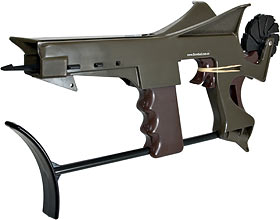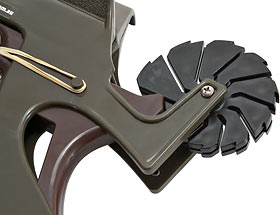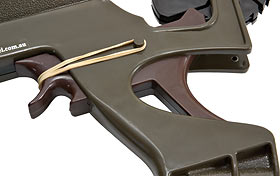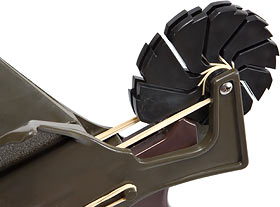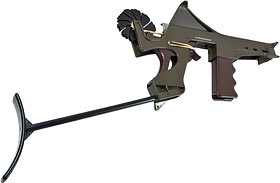
Firewheel rubber band gun
Review date: 11 December 2004.Last modified 08-Jun-2012.
Rubber band guns occupy a place in the aggressive-toy spectrum somewhere between M60s for children and hippy trippy bubble guns.
This is a good niche. Rubber band guns - RBGs, to their friends - really do shoot something, and you can plink at things with them, but it's basically impossible to do anyone any lasting harm with one. Yes, a band in the eye isn't fun, and I suppose someone could manage to inhale a band or something, but that's about it. RBGs aren't suitable for random shooting sprees at mellow cocktail parties, but tactical employment in many offices is likely to be acceptable.
It also doesn't hurt that you can buy thousands of rounds of ammo for an RBG for close to nothing. For exactly nothing, if you slip your ammo requisition in as part of your office's regular stationery order.
Rest assured that you'll need a whole lot of ammo, though, because the modern RBG has progressed somewhat beyond its muzzle-loading wooden ruler origins.
I checked out a couple of fine semi-automatic latex loop deployment devices a while ago. As I mentioned then, I particularly like Surefire's double-wheel guns, because they let you load up 24 bands (big nasty preserving-jar bands, in the case of the carbine and longer guns, which I regret to note don't seem to exist in twin-wheel variants any more...) and unload 'em as fast as you can pull the twin triggers.
These sorts of guns, though, have exactly one innovative component. It's the "star wheel" at the back of the weapon, that makes the whole thing work. You hook on one band on each tooth of the wheel, and every time you pull the trigger, a simple escapement mechanism lets the wheel click forward one tooth - which releases a band.
The rest of these guns isn't nearly as clever, though. Apart from the wheel mechanism, all they've got is a basic plastic or wood body with a notch at the front to retain the bands.
Bands can pile up on top of each other and jam, bands can whip off the end of the barrel at angles that qualify as inaccurate even by RBG standards, and if you get it into your head that you want to, say, unload all of the bands in one magnificent shotgun blast, you can't.
The Firewheel solves these problems.
More on exactly how it does that in a moment. First, just look at the thing.
Retro-futurism hipsters, ahoy! This isn't a 21st century gun; it's 1981's idea of a 21st century gun. TV Buck Rogers! Lieutenant Tawny Madison's weapon of choice! Pancor Jackhammer redesigned by John De Lorean!
OK, I've got that out of my system now.
This toy doesn't just look odd; it's odd to use, too. It's obviously related to the escapement-wheel kind of RBG, but evolution has warped it.
Look, for a start, at the wheel. It only holds ten rounds (versus 12 per wheel for the Surefire guns), and its spiral design means you always have to start loading it at the same point, rather than wherever you like. But there is method in its madness, thanks to...
...the trigger.
See how there are rubber bands wrapped around the front of what you might naively assume is a normal trigger? That's because this trigger works backwards - it's a large piece of plastic that sticks out the back of the grip, and you squeeze it forward with the heel of your hand to fire the Firewheel.
The effect of this strange design is that if you squeeze the trigger block forward just a little bit, only one sector of the spiral wheel will be allowed to click forwards, and only one rubber band will be released from its loading slot and fly off towards your TV, long-suffering big sister or obnoxious co-worker.
If you slowly squeeze the trigger more and more, one slot after another will fire. It doesn't take much practice to get good at this pseudo-semi-automatic fire.
If you squeeze the trigger by a larger increment, though, more than one slot will fire, more or less simultaneously. Short, controlled bursts..
If you push the trigger forward with authority, though, BAM - a fully loaded Firewheel will launch all ten of its bands with one click, leaving the wheel on the back spinning rapidly and your target looking shocked and awed.
This is the Metal Storm of RBGs, people.
Thanks to the design of the gun, it's also about as accurate as a smoothbore weapon firing aerodynamically disastrous ammunition can be expected to be. It actually does have a real barrel down which the band travels before flying off the peg on the end; there's a sort of rail inside the barrel, too, that's meant to help the bands fly straight.
The down side of this wizardry is that the Firewheel isn't as easy to load as you might hope.
The barrel's not a problem; the "wings" on the top of the gun guide bands down neatly through a slot into the right loaded position, so there's no fiddling there, unless you're trying a "magnum load" trick with extra-wide bands, or something.
But even when you're just using the ordinary roughly-45mm-diameter "size 16" office rubber bands the Firewheel's designed to take (experimentation may be called for), you'll find the wheel quite hard to rotate for the last few bands. I discovered several ergonomically disastrous ways to get bands onto the wheel, and have yet to master the slick one-handed speed-loading technique exhibited in the most excellent demo video you can download from this page (with authentic Australian voice-over!).
Even with practice, I doubt younger kids could get more than a couple of bands onto a Firewheel. That's probably a good thing.
The gun is well sized for adult hands...
...although the folding stock's a bit short, if you ask me.
But then again - this is a rubber band gun with a folding stock.
With the stock folded, the Firewheel's about 41cm long (16 inches); with the stock extended, it's a 63cm (25 inch) carbine. It's also got lugs that let you attach a strap to it if you like, by the way.
The Firewheel's solid, too, although it weighs only about 340 grams (12 ounces). It doesn't feel as if it's made out of Kevlar-filled polyunobtanium, but the body's one well-assembled lump, it and the stock are both made from ABS, and the nose spike and wheel are more flexible resin that shouldn't crack under band-strain or rough handling.
The trigger spring is just a couple more rubber bands, hooked over external pegs, so you can replace them with a couple of ammo-bands in about two seconds if they break - or go all gun-geeky and adjust the trigger tension by adding or removing bands.
The whole firing mechanism has only two moving parts and no hinges, plastic axles or other weak points (the wheel axle is part of the frame, held together with a metal screw), so I'm at a bit of a loss to think of ways in which the Firewheel could, realistically, break. The manufacturers seem to agree; the Firewheel has a lifetime warranty.
The Firewheel also comes with a comprehensive manual which contains handy tips like shaking up new bands in a plastic bag with a bit of talcum powder to reduce the chance of jams. The manual also, however, contains detailed, straight-faced information about the various ways in which you can simulate different kinds of real firearm with the Firewheel, how to use the sights, and so on. I wouldn't be surprised if there were real guns that came with less comprehensive documentation.
I, um, don't entirely buy this. I don't think we're going to be seeing an awful lot of SWAT teams conducting training exercises with Firewheels in the near future. But then again, if I were 13 and someone gave me this thing, I'd totally dig the manual. I think it may be aimed at the same readers as the one for Frontier, to which I alluded some years ago.
(The manufacturers have now confirmed that they weren't entirely serious when the wrote the documentation.)
There's nothing wrong with that sort of enthusiasm in a boy, of course. I loved reading about weapons when I was a kid, and I turned out just fine.
Buying one
Tasman Engineering Services, who make the Firewheel, are a small outfit based in Queensland, Australia, and they don't have what you'd call a huge distribution network yet. You can e-mail them for stockist details - but wait! Against all expectations created by the above, I am not about to tell you that if you live in the USA, the only way to buy one of these things is to send a money order in a currency of whose existence you are not entirely convinced to someone you don't know.
You can buy Firewheels on eBay, you see, in Australia and the USA. (Bizarrely enough, as I write this, they're listed in the "Sporting Goods -> Hunting" section. I wasn't aware that mosquito hunting was such a popular pastime.)
Anyway, on eBay you're looking at a mere $AU22.50 or $US17.40 plus postage for a Firewheel, and they're available in a dizzying array of colours. You even get a starter bag of rubber bands thrown in.
For a toy of this quality, that's a frickin' bargain.
Overall
Devices that take a long time to set up and a moment to gloriously, magnificently... do whatever it is that they do... have a certain je ne sais quoi, if you ask me.
Maybe this opinion is reflective of some deep-seated male impulse. But if you too can see the beauty of domino toppling, building implosions and professional or amateur pyrotechnics, then a Firewheel will also satisfy you.
If you want a toy gun that you can reload really easily, then something else might suit you better.
But the Firewheel is quite cheap, and its ammo is very cheap (thus solving the ancient all-of-my-sucker-darts-are-down-the-back-of-the-bookcase problem). And it shoots that ammo as accurately as anything could be expected to. And as rapidly as you like.
Put all that together, and the Firewheel becomes a no-brainer purchase for any toy-appreciator who's not deeply opposed to even the most innocuous "unnecessary thrills".
Highly recommended.
Review Firewheel kindly provided by Tasman Engineering Services.
Also available on eBay.
